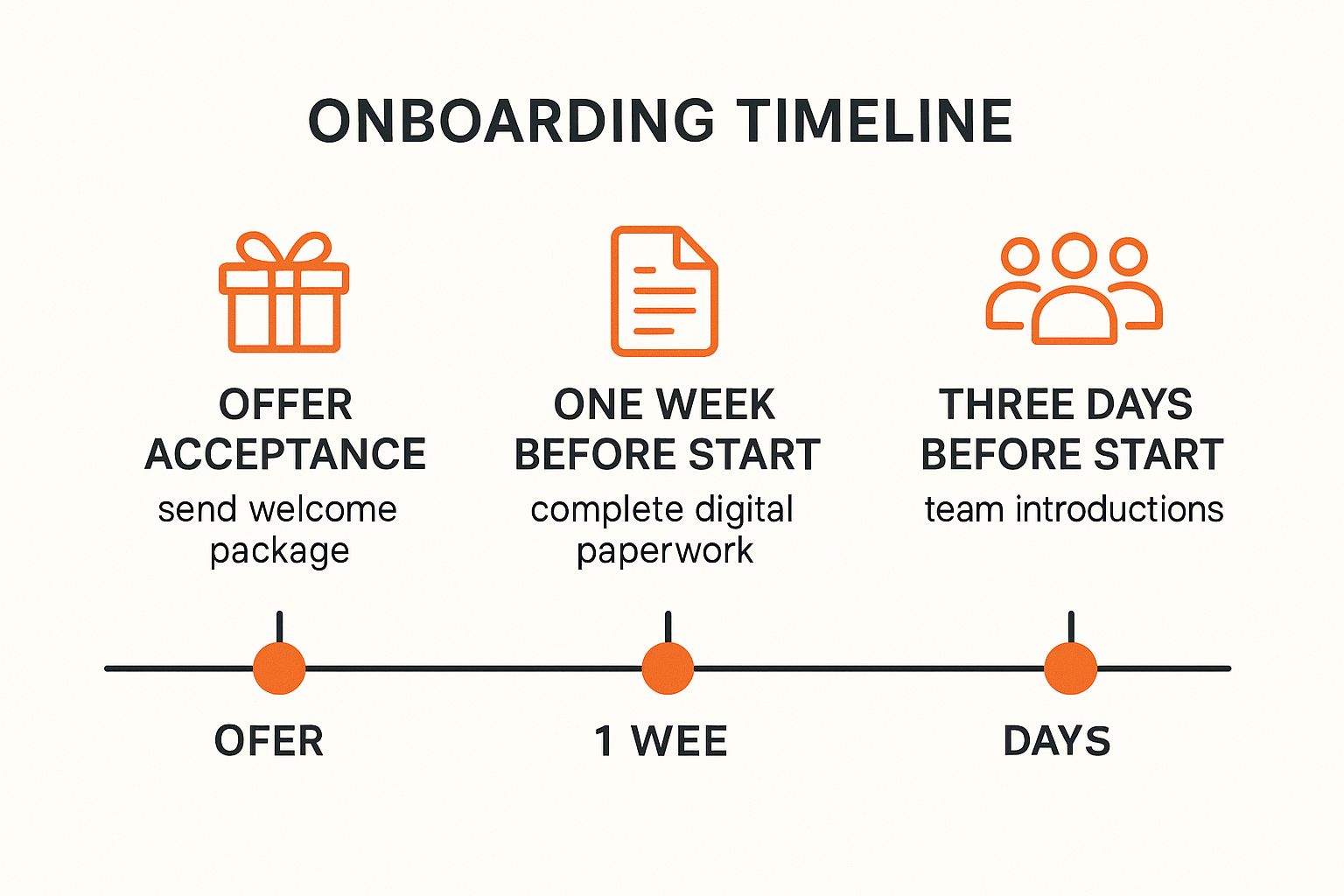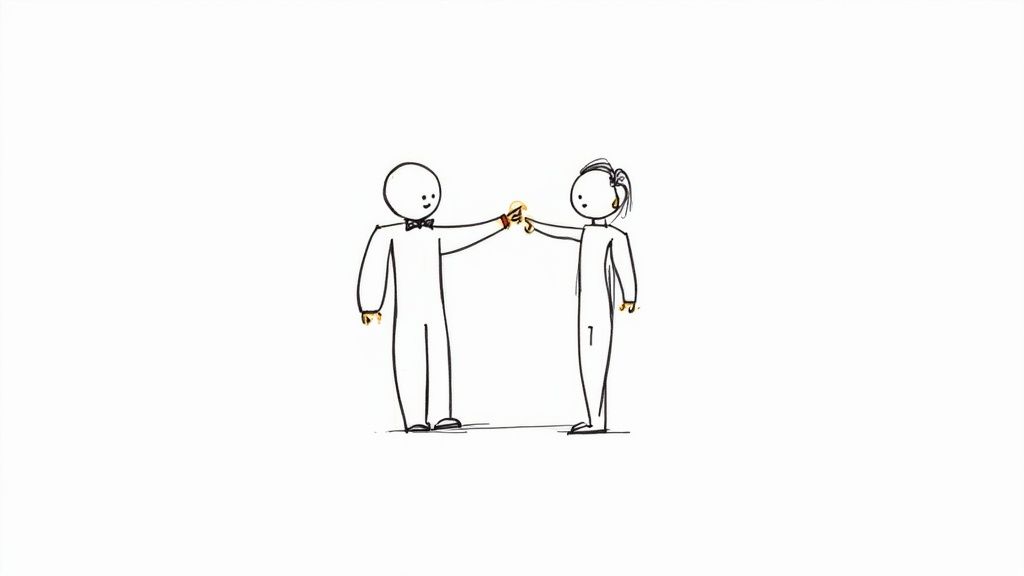Remember your first day at a new job? That universal mix of excitement and "what am I doing here?" anxiety is familiar to everyone. For instructional designers and L&D professionals, that feeling is our playground. The onboarding process isn't just about paperwork and IT setups anymore; it's the first and most critical learning experience an employee has with a company. A well-designed onboarding program sets the foundation for long-term success, and nailing it requires a thoughtful strategy grounded in proven instructional design frameworks like ADDIE and Agile SAM.
In today's hybrid work environment, the old one-size-fits-all approach just doesn’t cut it. We need to blend solid learning theory—cognitive load, spaced learning, and social learning—with the powerful tools at our fingertips, from slick Learning Experience Platforms (LXPs) and AI-driven adaptive pathways to microlearning modules created with Articulate Suite or immersive simulations in Adobe Captivate. This is where the real magic happens. By creating engaging, personalized journeys, we can directly impact retention, engagement, and how quickly a new hire feels like a valuable part of the team. For a comprehensive guide to successful onboarding, you can delve into additional employee onboarding best practices that cover the entire employee journey.
This listicle breaks down eight modern best practices in onboarding that bridge instructional design theory with the tech, like AI-powered LXPs, xAPI-driven analytics in your LMS, and microlearning delivered via Articulate Rise, that brings them to life. We’ll explore actionable strategies for every stage, from pre-boarding to the crucial first 90 days. Get ready to transform your onboarding from a one-day info dump into a dynamic, engaging journey that boosts retention and accelerates productivity from day one. Let's dive in.
The time between a candidate accepting an offer and their official start date is often a silent, anxious waiting game. Pre-boarding transforms this dead time into a powerful engagement opportunity. It's the process of connecting with your new hire before day one, building excitement, easing jitters, and setting the stage for a smooth transition. This phase is crucial for making new employees feel valued and part of the team before they even step through the door.
For instructional designers, pre-boarding is a golden opportunity to introduce your learning ecosystem early. Instead of a day-one information dump, you can deliver bite-sized cultural insights or an introduction to the company's mission through microlearning. Tools like Articulate Rise or Rise 360 are perfect for creating sleek, responsive modules that leverage cognitive chunking principles. Deliver these via your Learning Management System (LMS) or a modern Learning Experience Platform (LXP) with AI-driven personalization to adapt content based on user responses. This aligns with spaced learning theory—short bursts of content repeated over time—to enhance retention.
A successful pre-boarding experience is all about creating connection and clarity, not assigning work. Your goal is to make the new hire feel prepared and excited.
Key Insight: The goal of pre-boarding isn't to start training early. It's to build a cultural and emotional bridge, ensuring your new hire arrives feeling confident, connected, and ready to contribute from the get-go.
This timeline visualizes a simple yet effective pre-boarding sequence, mapping key touchpoints from offer acceptance to the days leading up to their start.

This structured approach ensures communication is consistent without being overwhelming, leading to a more prepared and engaged new employee.
Onboarding isn't a single-day event; it's a strategic process. The most effective onboarding extends well beyond the first week, often through the critical first 90 days. A structured 90-day program acknowledges that true integration and productivity take time. It transforms onboarding from a chaotic information dump into a guided journey with deliberate checkpoints, progressive learning, and continuous support. This approach ensures new hires build competence and confidence gradually, leading to higher retention and faster time-to-productivity.
For instructional designers, this is where you shine. A 90-day plan is the ultimate blended learning journey map, informed by the SAM model’s iterative design. You can design scaffolded modules in your LMS or LXP that phase in complexity: foundational microlearning in week one, scenario-based simulations in Adobe Captivate in week two, and live workshops or peer coaching sessions later. Incorporate Bloom’s Taxonomy by moving from remembering and understanding to applying and creating through real-world projects.
A great 90-day plan provides structure without being rigid. The goal is to create a clear path to success that empowers the new hire to take ownership of their role over time.
Key Insight: A 90-day plan is less about a rigid timeline and more about creating a psychological contract. It shows you're invested in the new hire's long-term success, not just their first-week survival.
This timeline visualizes a phased approach to the first three months, mapping out the progression from foundational learning to independent contribution.
This structured journey ensures new hires feel supported and clear on expectations, dramatically improving their chances of becoming engaged, high-performing team members.
No matter how well-structured your formal training is, new hires will always have those small, "silly" questions they're hesitant to ask their manager. A buddy or mentor program tackles this head-on by pairing newcomers with experienced, friendly team members who act as informal guides. This peer-level support system provides a safe space for asking anything, from navigating the company's unwritten social rules to finding the best coffee spot.
For instructional designers, a buddy program is a powerful supplement to formal learning pathways. While your meticulously crafted Articulate Rise modules can teach company processes, a buddy brings the company culture to life through social learning. This human connection accelerates social integration and makes the new hire feel genuinely welcome, which is a massive driver for long-term retention and engagement.

An effective buddy program is more than just a random pairing; it requires intentional design and support. The goal is to create a genuine connection that helps the new hire feel grounded and confident.
Key Insight: A manager's role is to direct and evaluate, while a buddy's role is to guide and support. This distinction is critical for creating psychological safety and is one of the most effective best practices in onboarding for accelerating a new hire's sense of belonging.
The one-size-fits-all orientation is dead. Effective onboarding recognizes that a new software engineer, a sales executive, and a senior marketing director all have vastly different needs on day one. Role-specific and personalized learning paths move beyond generic company-wide inductions to deliver tailored content that accelerates a new hire's unique journey to full productivity. This approach respects their existing expertise and focuses on closing specific knowledge gaps.
For instructional designers, this is where strategic L&D truly shines. Instead of a single, linear onboarding course, you design a modular, branched experience. Modern LXPs with AI-driven adaptive algorithms and sophisticated LMS platforms with xAPI analytics are built for this, allowing you to create a core curriculum and then branch into specialized tracks based on role, department, or even self-assessed skill levels.

The goal is to blend essential universal knowledge with highly relevant, role-specific training. A great example is Shopify's "Choose Your Own Adventure" style onboarding, which empowers new hires to select modules that align with their interests and role requirements.
Key Insight: Personalization isn't just about efficiency; it's about respect. It tells your new hire, "We see your unique skills and we're only going to teach you what you actually need to succeed here," which is one of the most powerful messages you can send.
This visualizes how different roles experience the onboarding process, starting from a shared foundation and branching into specialized tracks.
This structured yet flexible model ensures that while everyone gets the crucial cultural context, their learning is immediately relevant to their daily responsibilities.
Company culture is more than just a mission statement on a wall; it's the living, breathing set of behaviors, values, and assumptions that guide how work gets done. Culture immersion is the practice of deliberately embedding these principles into the onboarding process. Instead of treating culture as an abstract concept in a handbook, this approach uses storytelling, real-world experiences, and leader interactions to help new hires feel the culture from day one.

For instructional designers, this is where you move beyond compliance and skills training to shape employee identity and belonging. You can design powerful learning experiences that bring values to life. Imagine creating a scenario-based module in Articulate Storyline or Adobe Captivate where new hires navigate a tough decision that directly tests company values, or a gamified quiz on your LXP that unlocks employee stories about the culture in action.
A successful culture immersion plan makes your company’s values tangible and memorable. It’s about showing, not just telling, what it means to be part of the team.
Key Insight: True culture integration isn't a one-time presentation. It's an ongoing conversation that connects a new hire's daily tasks to the company's bigger purpose, creating a strong sense of alignment and emotional investment.
You can design the world's most beautiful and comprehensive onboarding program, but if a new hire's direct manager isn't engaged, it will fall flat. Manager enablement and accountability is the practice of equipping, empowering, and holding managers responsible for their new hire's integration. Research from Gallup and Marcus Buckingham consistently shows the manager relationship is the number one driver of engagement and retention, making this one of the most critical best practices in onboarding.
For instructional designers, this means shifting focus from solely creating new hire content to developing performance support for managers. This isn't about adding more to a manager's plate; it's about making their role easier and more effective. You can design job aids, conversation guides, or micro-modules within your LMS or LXP focused on onboarding leadership skills. For instance, a short Articulate Rise or Captivate module on "How to Run an Effective 30-Day Check-In" can be a game-changer for a busy manager.
A successful manager enablement strategy is proactive, providing just-in-time support and clear expectations. The goal is to transform managers from passive observers into active onboarding champions.
Key Insight: Onboarding is not just an HR function; it's a core leadership responsibility. Empowering managers with the right tools, training, and clear expectations is the most direct way to improve new hire success and long-term retention.
This framework outlines key areas where managers should be directly involved and accountable during the onboarding process, ensuring a consistent and supportive experience for every new employee.
By providing clear, structured support, you empower managers to build strong foundations with their new team members. Learn more about the essential leadership skills training topics that can be integrated into your manager enablement programs.
One of the strongest predictors of an employee's happiness and tenure is whether they have a "best friend" at work. Social integration goes beyond formal introductions, focusing on intentionally creating opportunities for new hires to build genuine relationships with their colleagues. This practice transforms the workplace from a collection of individuals into a supportive community, which is one of the most effective best practices in onboarding for boosting long-term engagement.
For instructional designers, this is where social learning theory comes to life. Fostering a connected environment directly impacts how knowledge is shared informally across the organization. You can facilitate this by designing onboarding activities in your LXP that encourage collaboration or by creating virtual spaces where new hires can connect. For example, a dedicated channel in your company's collaboration tool (like Slack or Teams) for a new hire cohort can be a simple but powerful tool for building community.
A successful social integration strategy feels natural, not forced. The goal is to lower the barriers to connection and create shared experiences that build camaraderie from day one.
Key Insight: Social integration isn't just about "fun activities." It's a strategic approach to building psychological safety and a sense of belonging, which are the foundations of a collaborative and high-performing team. These connections are the informal networks through which real learning and innovation happen. Learn more about what social learning theory is and how it applies here.
Onboarding shouldn't be a "set it and forget it" program. The most effective strategies treat onboarding as a living, breathing process that evolves. This practice involves systematically collecting feedback from new hires, analyzing performance data, and continuously refining the experience. It’s an agile approach that ensures your program remains relevant, addresses friction points, and adapts to the changing needs of your organization and its people.
For instructional designers, this is where your analytical skills shine. Moving beyond simple completion rates, you can leverage your LMS or AI-powered LXP to track engagement with onboarding content and correlate it with performance metrics. Tools like Culture Amp or Qualtrics can be integrated to automate feedback collection, providing the qualitative data needed to understand the why behind the numbers. This data-driven approach transforms onboarding from a static event into a dynamic, high-impact business function.
An iterative model is built on a cycle of action, feedback, and refinement. The goal is to make small, consistent improvements that compound over time, creating one of the best practices in onboarding.
Key Insight: Viewing your onboarding program as a product that is never truly "finished" is a powerful mindset shift. Each new hire provides valuable user data that you can use to debug, enhance, and optimize the experience for the next person.
This visualizes a simple yet effective feedback loop, showing how data collection and analysis lead to tangible program improvements.
By embedding this cycle into your process, you ensure your onboarding program not only welcomes new hires but also gets smarter and more effective with every person who goes through it.
So, we've journeyed from the initial "hello" of pre-boarding to the crucial feedback loops that refine your program. It's clear that modern onboarding is less about a frantic one-week information dump and more about a sustained, strategic experience. The days of handing a new hire a binder and wishing them luck are long gone, replaced by a much more intentional, human-centered, and technology-powered approach.
The best practices in onboarding we’ve explored aren't just isolated tactics; they are interconnected pieces of a larger puzzle. A personalized learning path is supercharged by manager enablement. A buddy program thrives on a foundation of cultural immersion. Each element supports the others, creating a comprehensive ecosystem designed to help new hires not just survive, but truly thrive.
The biggest takeaway for you, as an instructional designer or L&D professional, is the incredible opportunity to be an architect of this experience. We’re moving beyond static eLearning modules in Articulate Suite or Captivate and into a more dynamic, blended landscape. The future isn't about choosing between high-tech or high-touch; it's about seamlessly blending them.
Think about it:
This is where your expertise shines. Your role is to be the strategist who selects the right tool for the right job, combining instructional design theory with the practical power of today’s technology to create a journey that feels both efficient and empathetic.
Reading about the best practices in onboarding is a great first step, but putting them into action is what creates real change. You don't need to overhaul your entire program overnight. Start small, be iterative, and build momentum.
Here’s a simple action plan to get you started:
Ultimately, a world-class onboarding program is one of the most powerful levers for driving employee engagement, performance, and long-term retention. It’s your chance to make a powerful first impression that echoes throughout an employee's career. By embracing these best practices, you're not just welcoming a new person to a job; you're setting the foundation for their success and, in turn, the success of your entire organization. The future of onboarding is strategic, personalized, and deeply human, and you are the one who gets to build it.
Feeling inspired to transform your organization's onboarding but need the right talent to bring your vision to life? Whether you're looking to hire an expert instructional designer or find your next role in L&D, Relevant Training connects top-tier learning professionals with innovative companies. Check out our resources and job board at Relevant Training to build or join the team that’s creating the future of workplace learning.